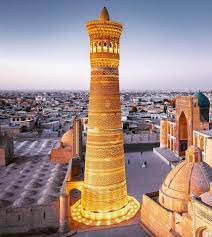SHARE WITH FRIENDS:
Buxoro - Minorai Kalon
The Kalon Minaret (Great Tower), the symbol of the city of Bukhara, was built by Arslan Bugrakhan, the Emir of the Karakhanid state in Movarounnahr.
Arslan Bughrakhan Muhammad ibn Sulayman (full name Muhammad ibn Sulayman ibn Dawud Kuchtegin ibn Tamgachkhan Ibrahim, 1130-1131) was the ruler of Movarounnahr (1102-1130). This Emir of the Qarakhanids was the son of Suleimantegin, the vassal of Barqiyaruq. He was enthroned in Samarkand in 1102 under the title of Arslankhan. He formed an army of 12 Mamluks and made several military expeditions to Dashti Kipchak. Due to paralysis at the end of his life, he ruled the throne in collaboration with his sons - first Nasr and then Ahmad. After the conquest of Samarkand by the Seljuks (March 1130, 13), Arslankhan was sent to Balkh and soon died there. He was buried in the madrasa he had built in Maur. Cultural life developed during the reign of Arslankhan. He built many buildings in Bukhara and its region. Of these: the Jarqurghon Tower and the minaret near the Kalon Mosque are still preserved.
As for the historical conditions of the period when the monument was built, the Samanid rule ended as a result of marches by the Qarakhanids to Movarounnahr in 992, 996, 999. During this period, the Seljuks began to threaten the Ghaznavids. A serious struggle begins with the Seljuks. In 1038, Ibrahim Boritegin, the local ruler of the Qarakhanids, seized the Amudarya regions of Khuttalon, Vakhsh, and Chaghaniyon from the Ghaznavids. Soon he began to pursue an independent policy, subjugating Movarounnahr and Fergana. As a result, the Karakhanids split into two independent states. One was the Eastern Karakhanids in the capital, Bolasog, and the other was the Karakhanid state in Movarounnahr, with its capital in Samarkand. By this time, the Karakhanid state, which was becoming increasingly politically weak, lost its former position, became oppressed by the Seljuks, and became dependent on it.
The construction of the Tower of Kalon dates back to the Middle Ages (XII century), more precisely to 1127. In the construction of the architectural monument, stone, special gravel alloy, chorsu baked brick, clay, wood and a number of other materials were used. As for its design, it is 50 meters high and 9 meters wide. The turtle-shaped upper part of the tower is decorated with brick carvings and turned into a cornice. The name of Arslankhan and the name of the master builder (master Baqo) are written in the middle of the arrow. Inside the tower, a brick spiral staircase leads to the mezzanine. The chair is angled, the body is convex, and the top is connected by a round cage with a dome. The tower narrows upwards and ends with a muqarnas. You can see the surroundings through the 16 arched windows in the cage. The top is reached by a 104-step staircase inside the tower. The mosque was a bridge over the minaret by Kalon. Both the core and the decoration of the Minaret Kalon are made of chorsu baked brick (27x27x4x5 cm) in ganchhok clay. Depending on the location of the decorative brick in different shapes, the surface is smoothly decorated. The overlapping decorative rings of various hand-shaped shapes are framed by brick dandelions. Among the ornaments there are Kufic inscriptions of historical and religious content. Each of the blue vinegar rings under the muqarnas is decorated in a different handicraft shape (later spilled).
As for the style of the architectural monument, the structure is made of baked brick in the style of ornamental forms of Eastern traditions. The peculiarity of the Kalon Minaret is that it differs from other buildings in Bukhara by its architectural solution. In addition, the architectural structure differed from other architectural structures in terms of height.
Historically, the minaret served as a place of call to prayer for the muezzin, and as an object of observation for military purposes. As for the condition of the tower to this day, its body and muqarnas have been repaired (1924). The underground base (chair) was opened and repaired by master Achil Bobomurodov (1960). In connection with the 2500th anniversary of the city of Bukhara, the Minorai Kalon complex was also renovated (1997). In addition, the area around the architectural structure has been landscaped and planted with greenery.
As for the attention paid to the monument by international organizations, it is included in the UNESCO World Heritage List. In 1993, the historical center of Bukhara (Session 1, Colombia) was included in the "List of World Cultural Heritage". On August 2000, 30, the Law "On protection and use of cultural heritage sites" was adopted. On September 2008, 12, the Law on Museums was adopted. These laws adopted by our state are a legal guarantee of the protection of architectural structures.
tourist.com


